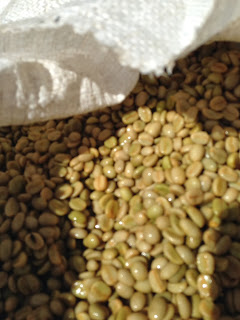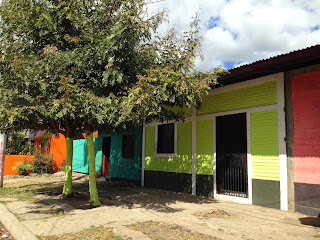Augusto, keeping watch over Managua International
Dateline: Cold-as-a-Coven-Member's-Left-Mammary, Outer-Artic, Seattle, WA
(yeah, in the USA)
Now I am writing in real time. I do not have to remember which tense I was supposed to be using and whether or not I was going to try to trick you, the reader, into thinking that I was recording every word of this blog AS-IT-HAPPENED. Because, because Dear One, if you think that that is true, you would be deluding yourself.
Now I am writing in real time. I am surrounded by a melange of crappy space heaters, Alexi Murdoch is filling the space of the Playhouse with a slight melancholy, just enough, and my mind is roaming back over the week. Too soon, too soon for any sort of conclusion. So......
Yesterday was a travel day. Thou shalt render unto the Travel Gods that which belongs to the Travel Gods. We milled about the bus, a few of the menfolk helping Samir load the big bags on the roof of the B-B. We made our goodbyes to Colin, who would not be riding to Managua with us. And then we departed.
The Bozo-Bus drifted down the Pan-American highway, shedding altitude and gaining heat. The back-the-bus-Bozos (and you know who you are) engaged in a lively trade of filthy jokes and the composition of bizarre blues lyrics. The last cigars of the trip were smoked, the volcanic cones drew into sight, and then we were passing the shores of Lake Managua. All too soon the airport hove into view and there we were on the sidewalk, burping our lighters like mad scientists, stowing our cutters in checked bags, trying to elude the evil claws of the TSA. This proved to be marginally entertaining street theater for the Nico redcaps lounging nearby.
Now I am writing in real time. Even with the heaters going, its coldish in the Playhouse. I'm smoking a small cigar and sipping tea. I am not surrounded by the Nicaraguan landscape rolling by the Bozo-Bus, or the echoes of the tile courtyard at our favorite hotel, or the raucous laughter of Los Hermanos. Now I am writing in real time.....
Point by point. That is how I view flying travel days, point by point, with the in-between of waiting. I do not kill time, for I do not want to anger Tock. I wait. Point: Check-in. Point: Passport control. Point: Security. You see? A series of small obstacles. I feel like a salmon swimming upstream over small waterfalls.
We were settled at the gate, the point of departure for the first leg, the flight to Houston. Who voluntarily goes to Houston? Isn't that like volunteering for Transportation, that most innocuous name that the English gave to the transshipment of convicts and undesirables. Yes, well, the joys of Texas will be the sport of another blog.
What one does not want to hear, unless one is on standby or waiting for an upgrade, is that scratchy gate intercom voice calling out one's name. "Will passenger......" No, No!! Let it not be me!! And son-of-a-bitch, it was me!
Three gringos called to the gate. Nicaraguan "TSA" cannot open anyone's bag unless that person is present. A fairly civilized regulation, that. We three had bags that required attention and our presence. Armed with out passports, we followed our leader out of the gate area, out of security (!), out of Passport control (!!) and into the concourse. We were disarmed of our passports at Immigration. As we passed that last point, we were now on foreign soil without that one most precious document. Danger Young Will Robinson!!
Traversing the entire concourse, we disappeared through one of those sets of doors that only minions are allowed to pass. The way is kept by the minions, the way is shut. Yet here we were, delving deeper into the bowels of the Managua airport until we came to a dead-end hallway. There, at this last point, was a sliding plexiglass window which looking into a small room containing a plain wooden table and a door, slightly ajar, that opened onto the briefest view of the baggage conveyor, the true entrails of an operational airport.
Over the window there was a big red button which, when pressed, caused an alarm bell to ring in the clanking beyond of the baggage area. After repeated ringings, another minion appeared, along with the bags of the tres' gringos. In a respectful fashion so unlike that of the TSA, our Nicaraguan baggage Jefe established that:
1) El Gringo Doctore had a lead x-ray shield in his bag and, as a volunteer on a humanitarian mission, was not a bad person. Passe, por favor.
2) El Gringo Dentisto had nothing in his bag that was of interest. Desculpe. Passe, por favor.
3) El Gringo de la Bozo had two puro lighters in his bag and was still functioning as the sacrificial lamb for Los Hermanos. After demonstrating that the lighters were, indeed, completely empty, la Bozo was allowed to both keep his lighters and passe, por favor.
We returned, point-by-point. Passports in hand (yay!) we were treated to a second security check and, finally, returned to our gate. Welcomed back, I was regaled with members of Los Hermanos showing me the various lighters, cutters, etc, that they had passed though security with. It is amazing the power that I unknowingly wield, power that can fend off the attention of the authorities by focusing said authority upon myself. Woo-Hoo, lucky me. Next time its someone else's turn. Given the result, the whole thing had turned into sort of a lark anyway, serving to help the time go by in a most interesting way.
Now I am writing in real time. My fingers are a little cold. No one is here to laugh with me. Even if I think up some other clever probing question about Collin's secret cigar blend, he isn't around to deflect it in an even more clever fashion.
Flying to Houston. We had the same flight attendant crew that worked the flight down. De-planing, one of our crew asked me if I wanted to fly back to Managua with them. I told them how mean they were, just down-right mean. Standing in the interminable Immigration and Customs line. Waiting in Houston, eating a salad (!), stretching aching muscles. Flying to Seattle, drifting in and out, bouncing in the turbulence. And then we were there, walking through a midnight airport, the purgatory of the damned and stranded. And then, and then, the Sundering of the Bozos and into the snow. But sundered only for a while and not really.
Now I am writing in real time. "I dreamed I stood beneath an orange sky, with my Brother standing by...." Alexi is singing. I am writing and smoking and trying to stay warm. I am resplendent in solitude, and yet also with the knowledge of the bonds of friendships strengthened, ties reforged, a mutual journey concluded and blessed memories. Yet more: new friendships begun and to be continued, horizons broadened as the world grows ever smaller, more strange places become familiar.
Now I am writing in real time. I want to dedicate this blog to everyone who had a hand in this journey. Thank you, one and all. Hearty thanks to the group, to Colin and Andrea and Samir, and to each of the people in Nicaragua who so generously shared their time and knowledge and smiles with us. I specifically want to dedicate this post to my very dear friend Mark Hansen, who called me this morning specifically to tell me how much he enjoyed these posts. That kind of encouragement is the fuel that keeps me going, hack that I am.
There will be a bit more to come on the subject of Nicaragua. In my attempts to chronicle events, I have had almost no time to reflect on what I learned on this journey. The blog is not at an end, not yet. But now I am writing in real time.

















































